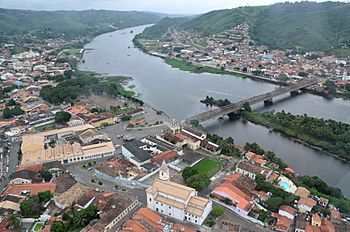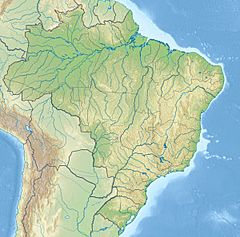Paraguaçu River facts for kids
Quick facts for kids Paraguaçu River |
|
|---|---|

The river between Cachoeira (left) and São Félix (right)
|
|
| Country | Brazil |
| Physical characteristics | |
| River mouth | Baía de Todos os Santos 12°50′01″S 38°47′40″W / 12.833597°S 38.794503°W |
The Paraguaçu River (called Rio Paraguaçu in Portuguese) is a very important river in the state of Bahia, located in eastern Brazil. It flows for about 500 kilometers (310 miles). The river starts in the high lands of the Chapada Diamantina mountains. It then travels all the way to the Baía de Todos os Santos, which is a large bay.
The Paraguaçu is the biggest river that stays completely within Bahia state. Its sides are very rich in good soil for farming. The cities near its mouth can be reached by boats. For a long time, the river was a main way to travel and communicate. This was true both before and during the time of Portuguese rule. Today, the lower part of the river is home to the Baía do Iguape Marine Extractive Reserve. This special area was created in 2000 to protect nature.
Contents
What Does "Paraguaçu" Mean?
The name "Paraguaçu" comes from the Tupi language. It means "great river." It is a mix of two words: "pará," which means river, and "gûasu," which means great. In the past, during the colonial period, people spelled its name in different ways. Some of these spellings included Paraoçu, Paraossu, Peroguaçu, Perasu, Peoassu, or Peruassu.
Where Does the Paraguaçu River Flow?
The Paraguaçu River begins in the Chapada Diamantina highlands. These are mountains in central Bahia, following a chain called Sincura. The river flows east for about 500 kilometers (310 miles). It finally empties into the Baía de Todos os Santos.
The river's path can be split into two main parts:
- The sertão: This is the drier, upper part of the river.
- The Recôncavo: This is the lower part of the river.
The Sertão Region
In the dry sertão region, the Paraguaçu River helps support cattle farms. In the past, the river was a key spot for moving cattle. Farmers from the wider sertão areas of Bahia and Minas Gerais used it. Tropeiros, who were cattle drivers, built places to rest along the river. Farmers also built small chapels dedicated to their favorite saints.
The Recôncavo Region
The lower part of the Paraguaçu River flows through the Recôncavo. This is a very fertile area. It was once famous for growing sugar cane and tobacco. Because of this, there were many sugar mills and cigar factories here.
In the early days of Portuguese rule, the Recôncavo had the largest number of African enslaved people. This region remained a center of slavery until it was ended in 1888. Today, the lower parts of the river have many old convents and churches from the colonial period. You can see these in towns like São Félix, Cachoeira, and Maragojipe.
About 40 kilometers (25 miles) of the river can be used by boats. This part stretches from the town of Cachoeira all the way to where the river meets the sea.
At the very end of its journey, the river widens into the Iguape Bay. This bay is an arm of the large Bay of All Saints (Baía de Todos os Santos). The Iguape Bay is protected by the Baía do Iguape Marine Extractive Reserve. This reserve covers about 10,074 hectares (24,893 acres) and was created in 2000 to protect the local environment.
History of the Paraguaçu River
Many important historical places are found along the Paraguaçu River. These include the old city centers of Jaguaripe, Cachoeira, and São Felix. The Parish Church of Santiago and the old parts of the Convent and Church of Saint Antony are located on the Iguape estuary.
The river's path also followed a rich area where diamonds were found. This led to many people coming to search for diamonds. These mines were named after the mountain range and became known as the mines of Sincura.
In December 1989, the river flooded after very heavy rains. This flood affected 175 towns and cities. It also caused landslides. The flooding sadly killed 35 people and forced 200,000 people to leave their homes.
Images for kids
See also
 In Spanish: Río Paraguazú para niños
In Spanish: Río Paraguazú para niños



